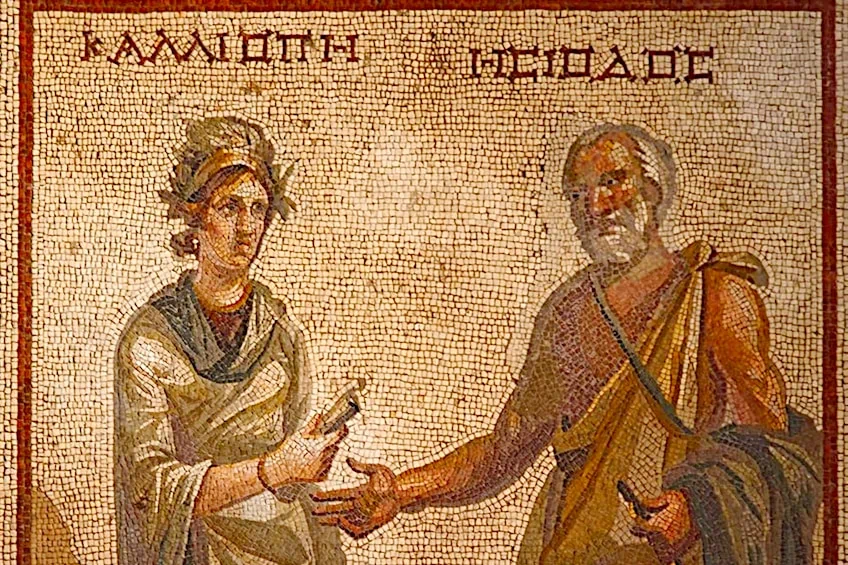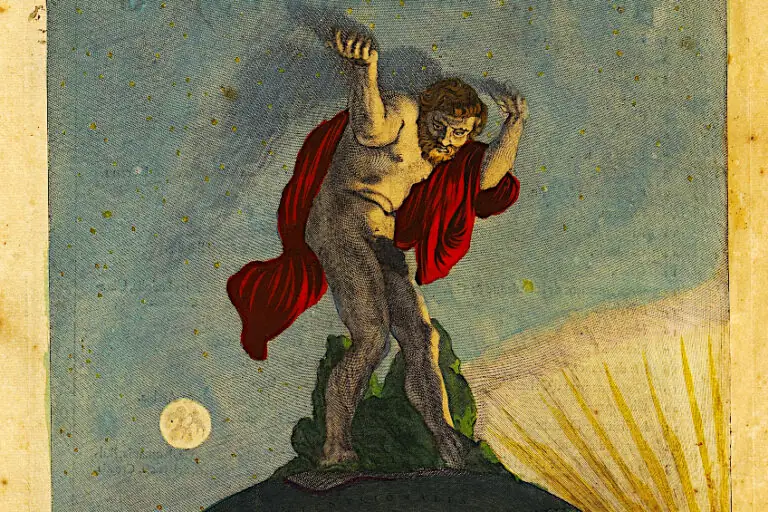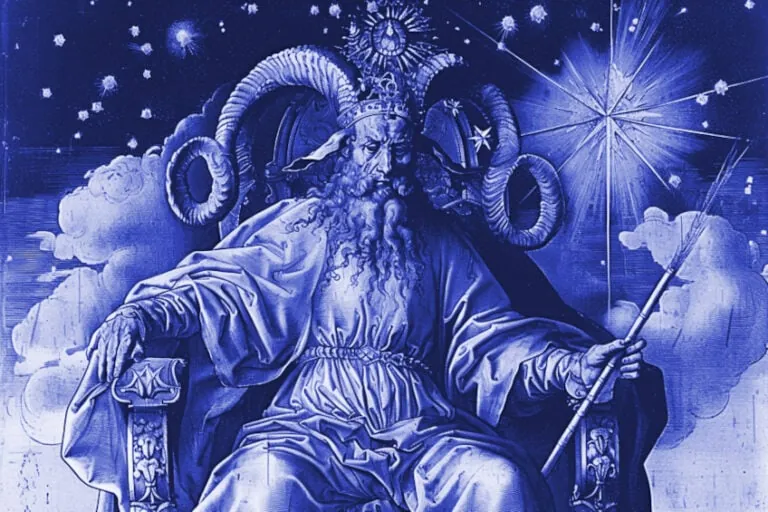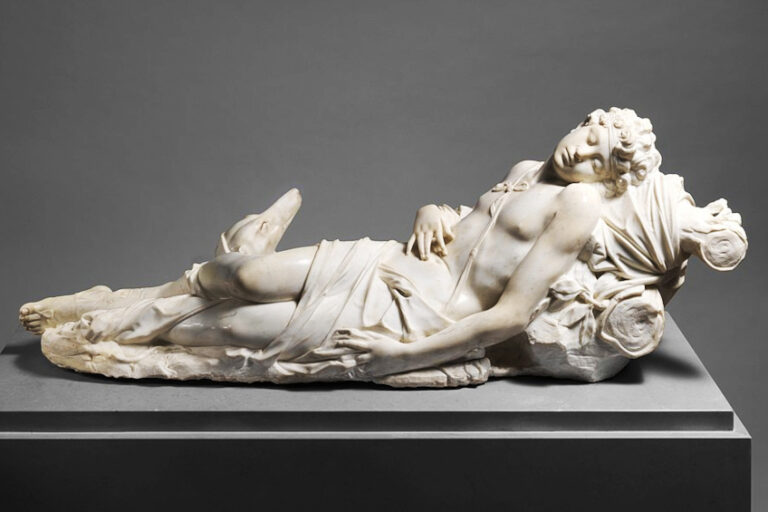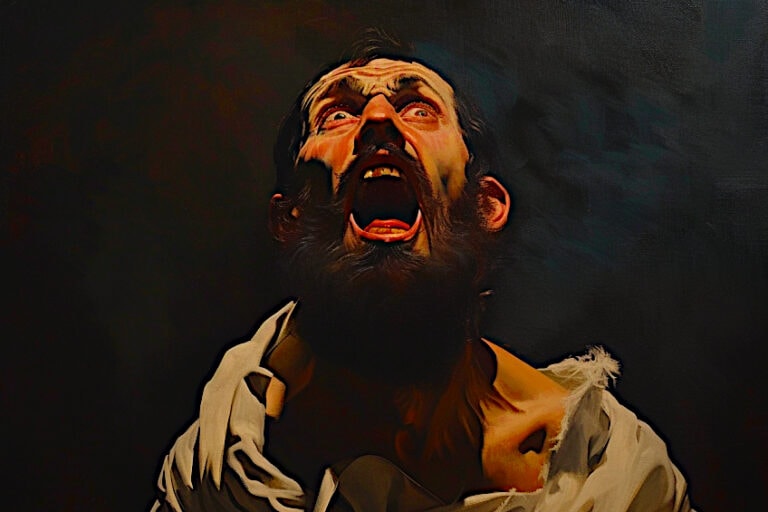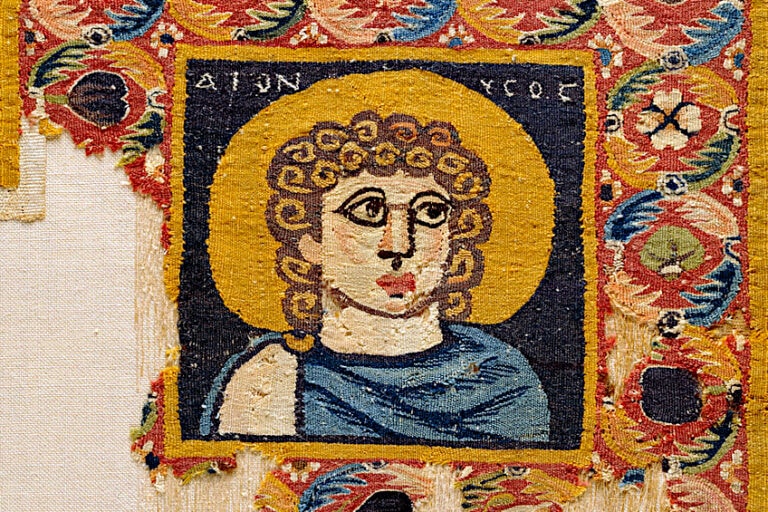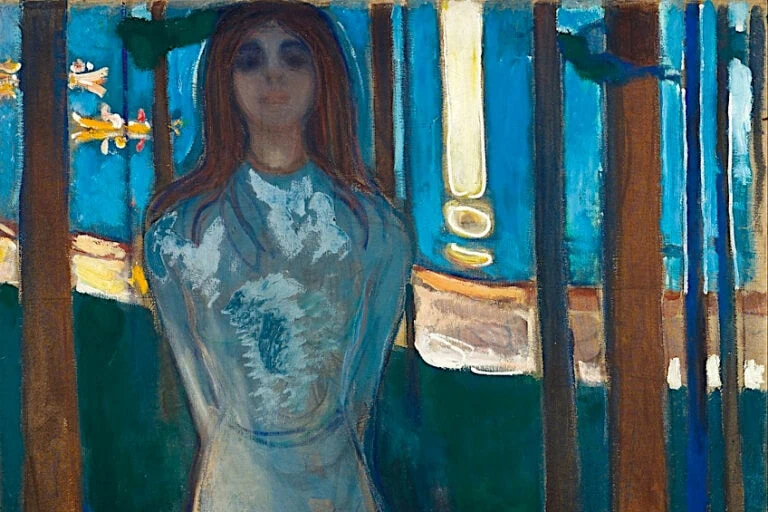The Muses in Greek Mythology – Divine Sources of Knowledge
The Muses in Greek mythology were regarded as the source of inspiration for all knowledge and the arts. The Greek Muses were the companions of Apollo, as well as the daughters of Mnemosyne and Zeus. These nine goddesses started as the ancient oral poet’s primary source of information, before becoming patrons of various arts and sciences. Let’s find out more about the names of the muses and the roles they played below.
Contents
The Role of the Muses in Greek Culture
In antiquity before the use of writing, the important histories and stories that encapsulated a culture’s social values and religious ideas were preserved and transmitted not via books or documents, but by oral poets. These singers were trained in the mnemonic arts, using various techniques to enable them to recite complex narratives with remarkable consistency and accuracy. But how could an audience be certain the poet was not just making things up?
In ancient Greece, poets took great care to ensure their audiences that they enjoyed a special relationship with the goddesses tasked with observing and reporting everything that happened across the world.
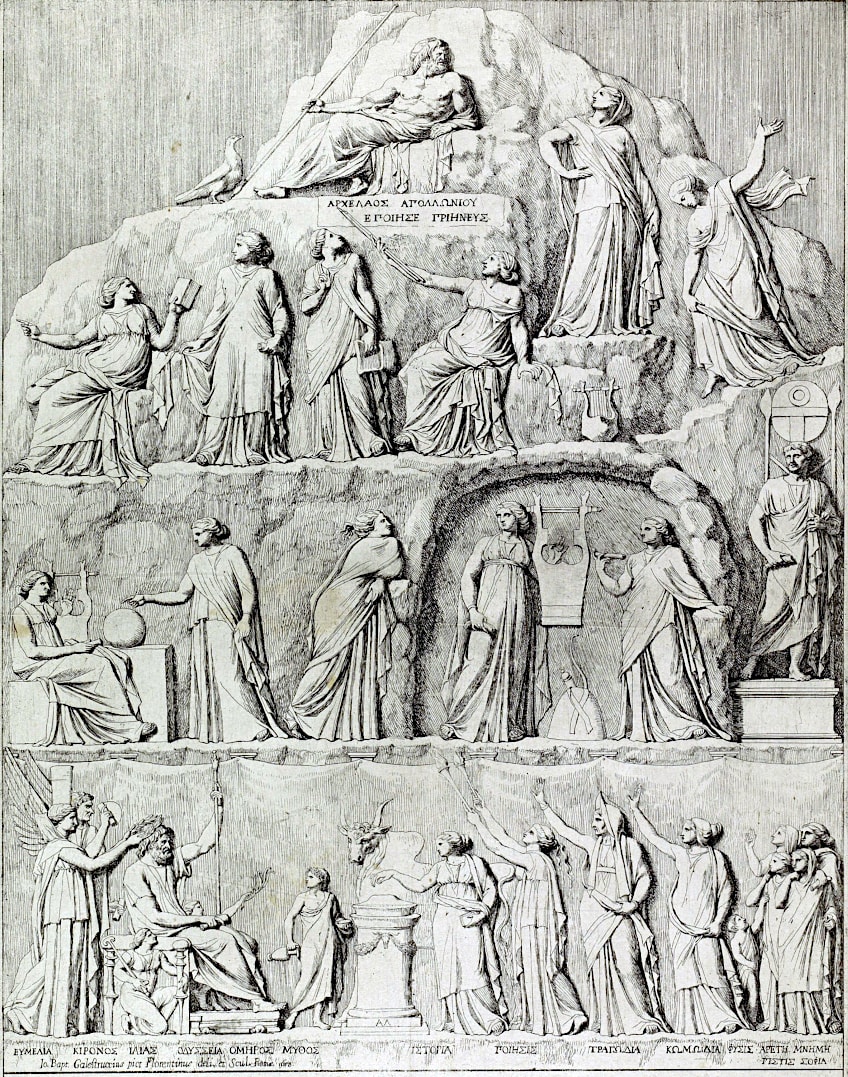 Print of Archelaos of Priene’s 3rd Century BCE relief showing the apotheosis of Homer. The Muses appear in the registers above with Zeus on his throne at the apex by Giovanni Battista Galestruzzi (1658); Rijksmuseum, CC0, via Wikimedia Commons
Print of Archelaos of Priene’s 3rd Century BCE relief showing the apotheosis of Homer. The Muses appear in the registers above with Zeus on his throne at the apex by Giovanni Battista Galestruzzi (1658); Rijksmuseum, CC0, via Wikimedia Commons
In his preamble to the lengthy account of all the Greek contingents that came to Greece, Homer says that the Muses are present whenever anything happens, and therefore they see and know everything. By contrast, singers can only hear the Muses’ description of distant events. Hesiod likewise says that “the Muses speak of what is, and what is to be, and what was before now.” However, when he first meets the Muses, they warn him that even though they speak the truth, they can also say things that resemble the truth.
In addition to being able to request information from the Muse and hear their response, the great poets also boasted that the Muses gifted their chosen humans a special type of voice. Hesiod for example, described the Muses making him a poet by “breathing a voice into him”, while the singer Thamyris had his divine voice taken from him by the Muses when he angered them.
When writing became widespread, the role of the Muses evolved and gradually nine specific goddesses became associated with various arts and sciences, where they were believed to inspire and guide people who excelled in these. Now not only poets and musicians, but also scientists, actors, playwrights, scholars, and philosophers were considered to have a special relationship with the particular Muse who presided over their area of expertise.
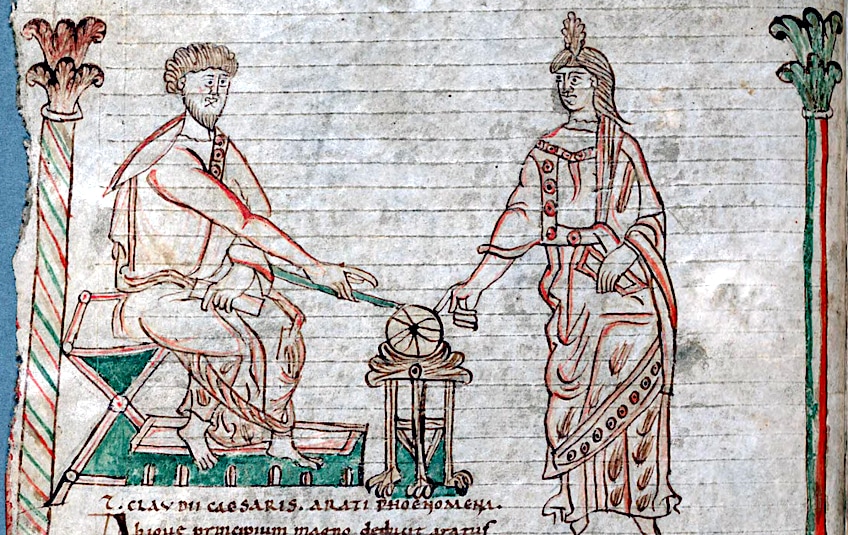 Scientist guided by the Muse Urania from a Medieval manuscript on astronomy (between 1001 and 1100); National Library of Wales, CC0, via Wikimedia Commons
Scientist guided by the Muse Urania from a Medieval manuscript on astronomy (between 1001 and 1100); National Library of Wales, CC0, via Wikimedia Commons
Mythology
The number, names, and parentage of the Muses differed widely from one region to another. Amongst the most ancient traditions was of the three Muses of Mount Helicon named Melete (practice), Aoede (song), and Mneme (Memory). The nine Thracian Muses from Piera were collectively referred to as the Pierides and associated with the cults of Orpheus and Dionysus. The name Perides was also given to the nine daughters of Pierus who challenged the Muses to a contest and lost.
![]() White-ground lekythos depicting two Muses identified as Heliconian by the inscription below the rock the Muse sits on. Attributed to the Achilles Painter (c. 445-435 BCE); ArchaiOptix, CC BY-SA 4.0, via Wikimedia Commons
White-ground lekythos depicting two Muses identified as Heliconian by the inscription below the rock the Muse sits on. Attributed to the Achilles Painter (c. 445-435 BCE); ArchaiOptix, CC BY-SA 4.0, via Wikimedia Commons
In Delphi and Sicyon three Muses were worshiped, while Lesbos venerated seven Muses, and another tradition named only four. Their parentage also ranged from Uranus and Gaia to Pierus and Antiope. In some traditions their father was Apollo, in others they were the daughters of Zeus by goddesses such as Menmosyne, Minerva, Plusia, Aether or Gaia.
In the Theogony Hesiod is initiated as a singer by the Heliconian Muses, however, it was the nine Olympian Muses born from Zeus and Mnemosyne, whose names he provides, and origins he narrates who were to become the pan-Hellenic canon.
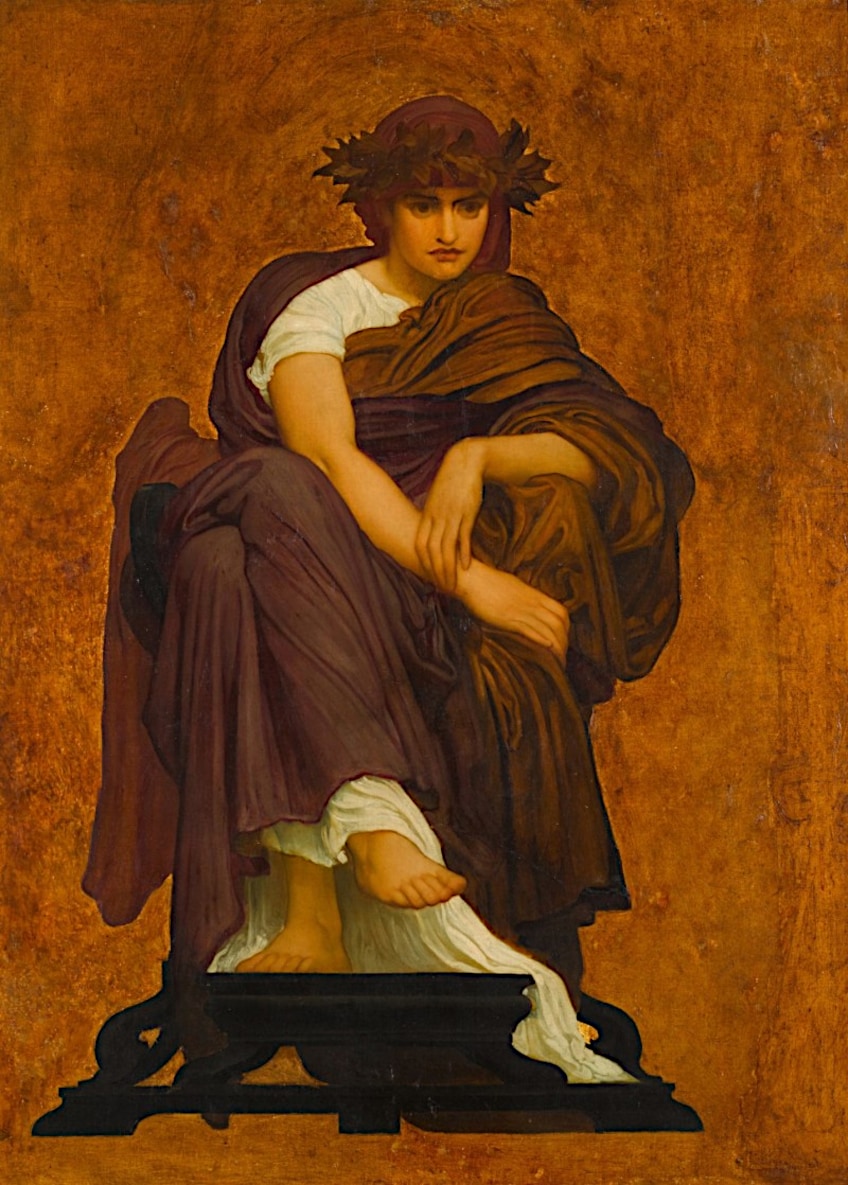 Mnemosyne, Mother of the Muses by Frederic Leighton (1884); Frederic Leighton, Public domain, via Wikimedia Commons
Mnemosyne, Mother of the Muses by Frederic Leighton (1884); Frederic Leighton, Public domain, via Wikimedia Commons
Hesiod describes how Zeus visits the Titanide Mnemosyne after establishing his new reign and spends nine nights with her. When she gives birth to the Muses, the poet notes that their function is to celebrate Zeus’ new world order. They become divine chroniclers of the Olympian gods, observing, preserving, and broadcasting the achievements of the gods and heroes through their mouthpieces, the poets.
Keep in mind that in oral cultures, reputations and events are made known and remain only as long as people speak of them.
The Muses are sometimes associated with water nymphs since they are linked with the Pieris and Helicon springs. The winged horse Pegasus was claimed to have touched his hoof to the earth in Helicon, causing four sacred springs to spring forth, from which the Muses, sometimes known as pegasides, were formed. Later, Athena tamed the wild horse before offering him to the Greek Muses. They adjudicated a contest between Marsyas and Apollo in one tale. They also took the remains of Orpheus, Calliope’s son, and interred them in Leivithra.
But the Muses were not all sweetness and light, they could severely punish those who angered them. Not even the monstrous Sirens escaped punishment for daring to compare their intoxicating singing to the music of the Muses.
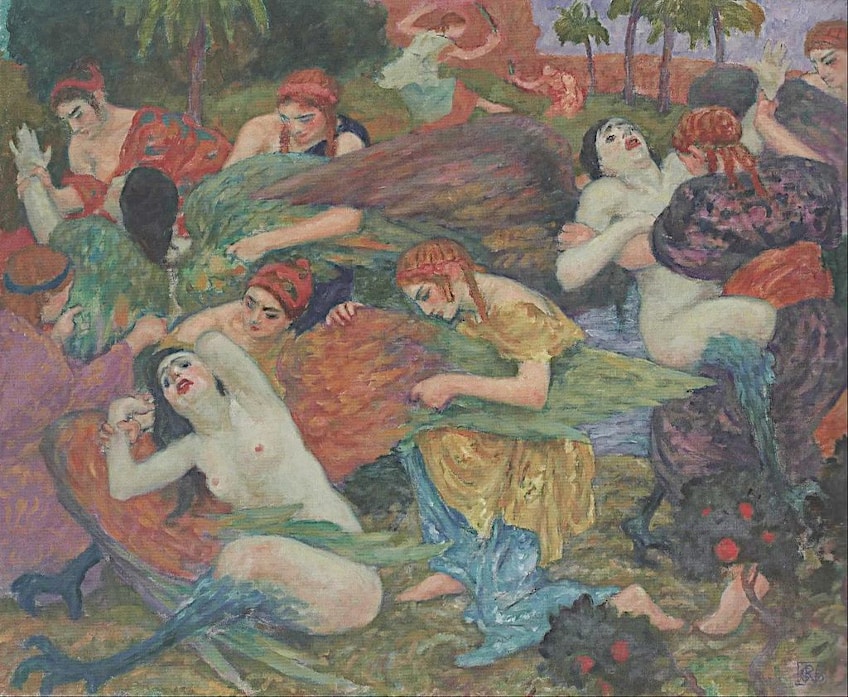 The Muses Plucking the Wings of the Sirens by Rupert Bunny (c. 1922); Rupert Bunny, Public domain, via Wikimedia Commons
The Muses Plucking the Wings of the Sirens by Rupert Bunny (c. 1922); Rupert Bunny, Public domain, via Wikimedia Commons
Thamyris and the Muses
Thamyris was a gifted Thracian bard recognized for his extraordinary musical and literary ability. According to legend, he got overconfident in his abilities, boasting that he was capable of outperforming the nine goddesses of the arts. Angered by Thamyris’ pompous declaration, the Muses confronted him at a place called Dorion and severely punished him.
In Homer’s telling of the myth, Thamyris is maimed, deprived of his divine voice and his memory for playing his kithara (a large type of lyre).
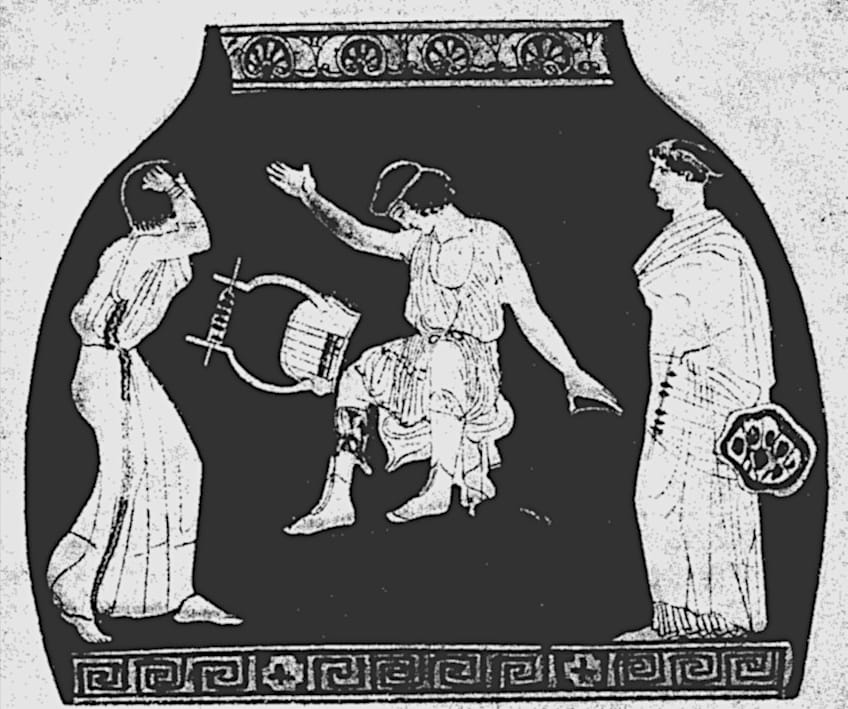 Thamyris discarding his Kithara; anonymous Ancient Greek vase painter, Public domain, via Wikimedia Commons
Thamyris discarding his Kithara; anonymous Ancient Greek vase painter, Public domain, via Wikimedia Commons
In other accounts of the myth Thamyris is not just a singer, but a Thracian king and a son of one the Muses (Erato or Melpomene). His challenge was also said to have included a condition that if he won the competition he could make love to every one of the Muses. In most versions, his punishment extended beyond losing his voice and memory to being blinded by the Muses. In art Thamyris was often portrayed throwing his now useless lyre into the Balyra (to throw + lyre) river.
Demodocus and the Greek Muses
While the Muses took Thamyris’ talents away in the story above, they also had the ability to bestow talents on individuals. In the Odyssey, Odysseus is hosted at the Phaeacian island of Scheria after many years of traveling and hardship by Queen Arete and King Alcinous. During the dinner, a blind singer named Demodocus is summoned to sing for the guests.
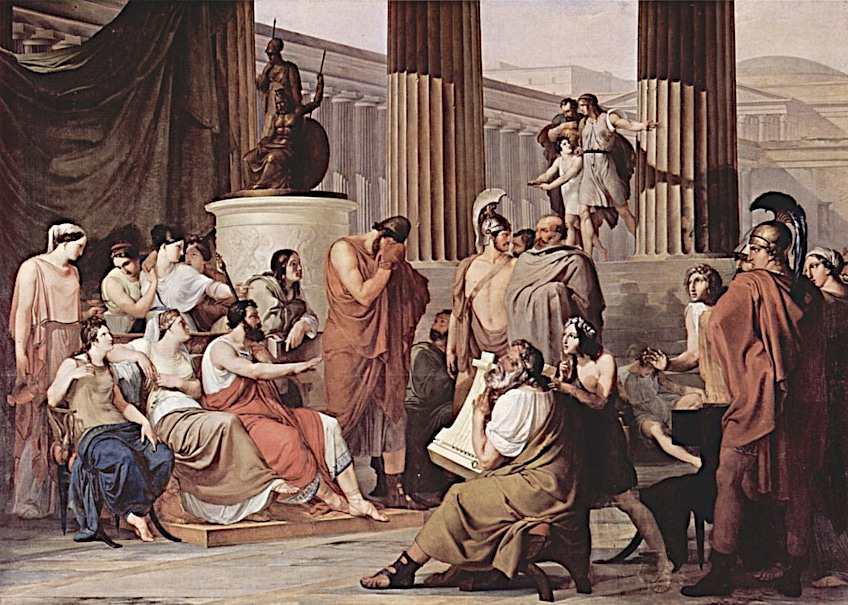 Odysseus at the Court of Alcinous by Francisco Hayez (1814-15); Francesco Hayez, Public domain, via Wikimedia Commons
Odysseus at the Court of Alcinous by Francisco Hayez (1814-15); Francesco Hayez, Public domain, via Wikimedia Commons
Demodocus enchanted everyone in the room. His song made all those present feel both sorrow and joy. Odysseus was so moved by his performance that he began to cry when he heard the account of the Trojan War, which reminded him of his own experiences during that war and his longing to return home. Homer explains that Demodocus was gifted the “sweetest song” by the Muses in exchange for his blindness.
Demodocus has long been regarded as the model for the myth that Homer was blind.
The association of blindness with the great epic poet has been linked to Homer’s assertion in the Iliad that the Muses were the ultimate eyewitnesses and poets did not have to observe the things they sang of directly, but only needed to hear the goddesses’ report of distant events to be able to recount them.
The Pierides and the Greek Muses
According to legend, King Pierus had nine daughters collectively known as the Peirides. He not only gave them the same names as the Muses, he also claimed that they were more accomplished and proficient in the arts than the goddesses. Pierus was said to have challenged the Muses to compete against his daughters. This competition was held in the Muses’ holy forest on Mount Helicon, which was regarded as their home. Each side displayed their creative abilities in turn, with the Pierides seeking to equal the Muses’ heavenly gifts in song, music, dance, and poetry.
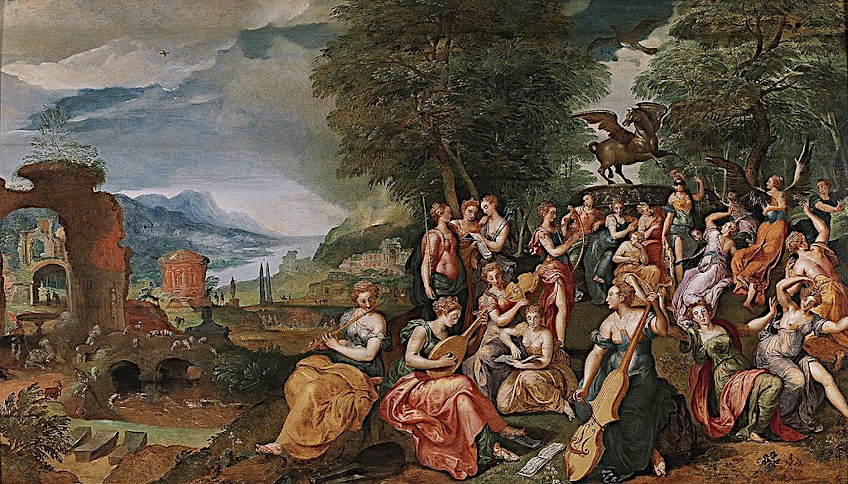 The Contest between the Muses and the Pierides by Maerten de Vos (16th Century); Maerten de Vos, Public domain, via Wikimedia Commons
The Contest between the Muses and the Pierides by Maerten de Vos (16th Century); Maerten de Vos, Public domain, via Wikimedia Commons
Despite their best attempts, the Pierides were incapable of competing with the Greek Muses. In all areas of the competition, the Muses successfully surpassed Pierus’ mortal daughters. The Pierides were changed into birds as a punishment for their hubris and folly in defying the Muses. The specific bird varies in different versions of the narrative, although they were most usually transformed into magpies. These changed magpies kept their capacity to mimic human speech but lost their creative abilities and knowledge.
The name Pierides was also used to refer to the nine Thracian Muses who were worshiped on Mount Piera, as opposed to the Muses who lived on Mount Helicon, or the chorus of Muses who kept company with Apollo on Mount Parnassus. The Pierides were also more closely associated with the mystery cults of Orpheus and Dionysus.
The Nine Goddesses of the Arts
In the opening line of the great epic poem the Iliad, Homer asks the Muse to “sing of the rage of Achilles”. Elsewhere Homer addresses these goddesses as “Muse”, “Goddess”, or Daughters of Zeus”, but never names them. In the Odyssey however, Homer does describe nine Muses lamenting the death of Achilles. The number nine and the names now most closely associated with the Greek Goddesses of the arts first appears in Hesiod’s Theogony.
The naming of the Muses follows a passage where the poet describes their activities, and scholars have long pointed out that their names derive from words used in that passage.
This has lead some to speculate that these names were the invention of the Hesiodic tradition, while others argue that the preceding passage was an attempt to explain the etymology of names traditionally associated with the Muses. Either way, by the Classical period Hesiod’s chorus became the most widely used and accepted set of Muses.
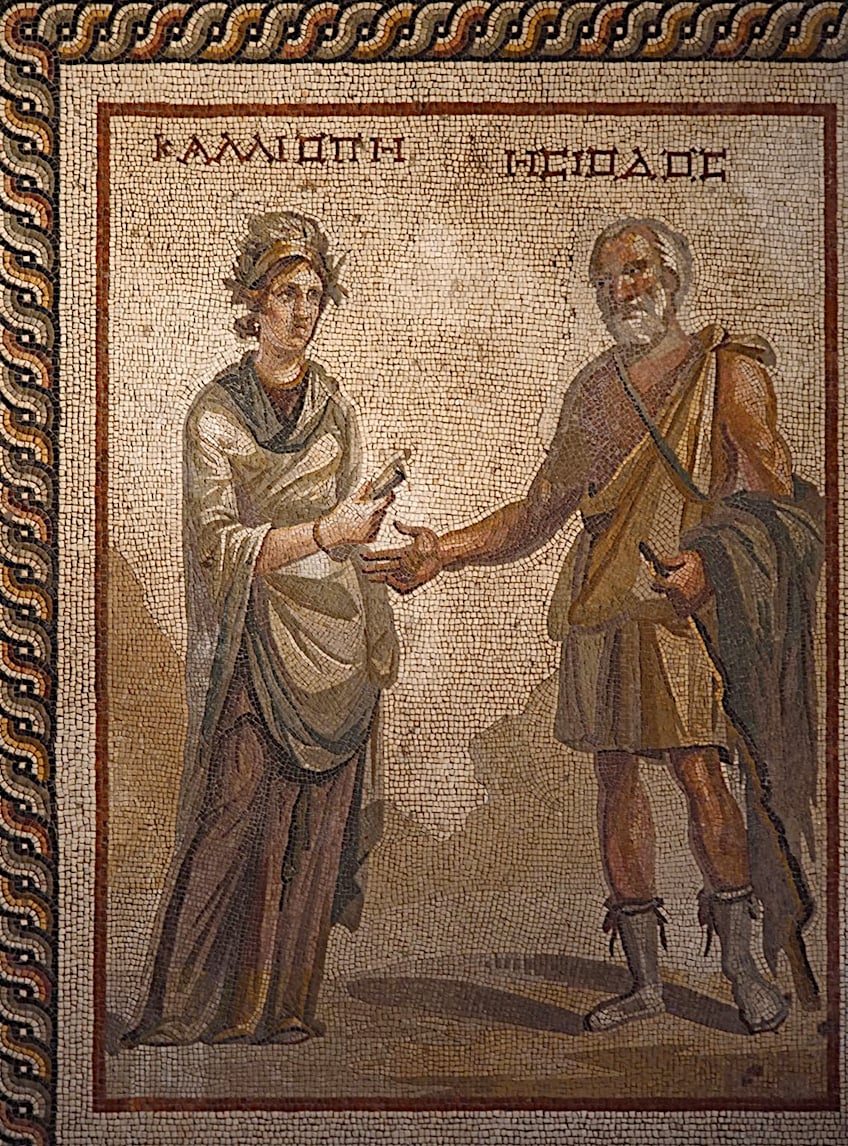 Detail from a mosaic depicting the Muse Calliope with the poet Hesiod (2nd Century CE); Dosseman, CC BY-SA 4.0, via Wikimedia Commons
Detail from a mosaic depicting the Muse Calliope with the poet Hesiod (2nd Century CE); Dosseman, CC BY-SA 4.0, via Wikimedia Commons
While Hesiod only ascribed a special function to the chief Muse Calliope, the idea that each Muse presided over a specialist field eventually became widespread. Depictions of great poets and scholars with the nine Muses holding the symbols of their areas of specialization were poplar themes for mosaic floors in grand Greek and Roman homes.
Calliope
| Parents | Mnemosyne and Zeus |
| Known For | Eloquence and poetry |
| Portrayed With | Tablet and stylus; scroll; trumpet |
| Etymology | kalos (beautiful/perfect) + ops (voice) |
Calliope is the eldest of the nine Muses and is associated with eloquence and epic poetry. Hesiod gave Calliope had a prominent position among the Muses as the one who infused kings with a commanding and persuasive voice. Calliope was most typically portrayed as an attractive young woman dressed in a golden gown and a variety of garments. She is also often portrayed with a parchment scroll or a tablet and stylus, and occasionally she holds a trumpet.
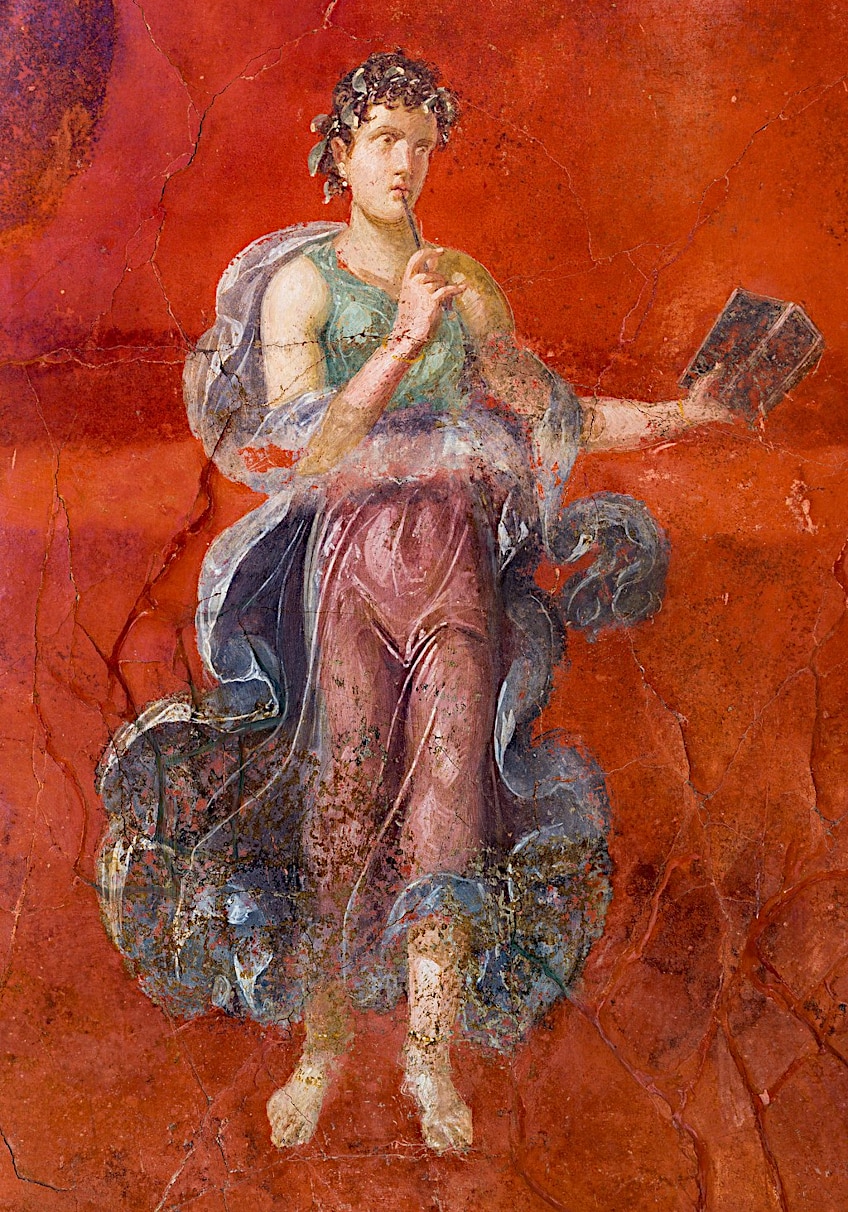 Roman Fresco depicting the Muse Calliope from Pompeii (c. 64 CE); ArchaiOptix, CC BY-SA 4.0, via Wikimedia Commons
Roman Fresco depicting the Muse Calliope from Pompeii (c. 64 CE); ArchaiOptix, CC BY-SA 4.0, via Wikimedia Commons
In mythology Calliope was the mother of the famous musicians Linus and Orpheus, in some accounts it was Calliope instead of the centaur Charon who trained Achilles to play the lyre and sing.
Clio
| Parents | Mnemosyne and Zeus |
| Known For | Memory and history |
| Portrayed With | Scroll; book chest; water clock |
| Etymology | kleos (renown/fame) |
Clio, the goddess of memory and history, is the first Muse Hesiod names in his catalogue. Clio is sometimes referred to as “the Proclaimer” and was commonly depicted holding a scroll and sitting or standing beside an open book chest. Some later imagery of Clio would also include a water clock. Clio is the name of several contemporary brands, notably the Clio Awards for advertising excellence
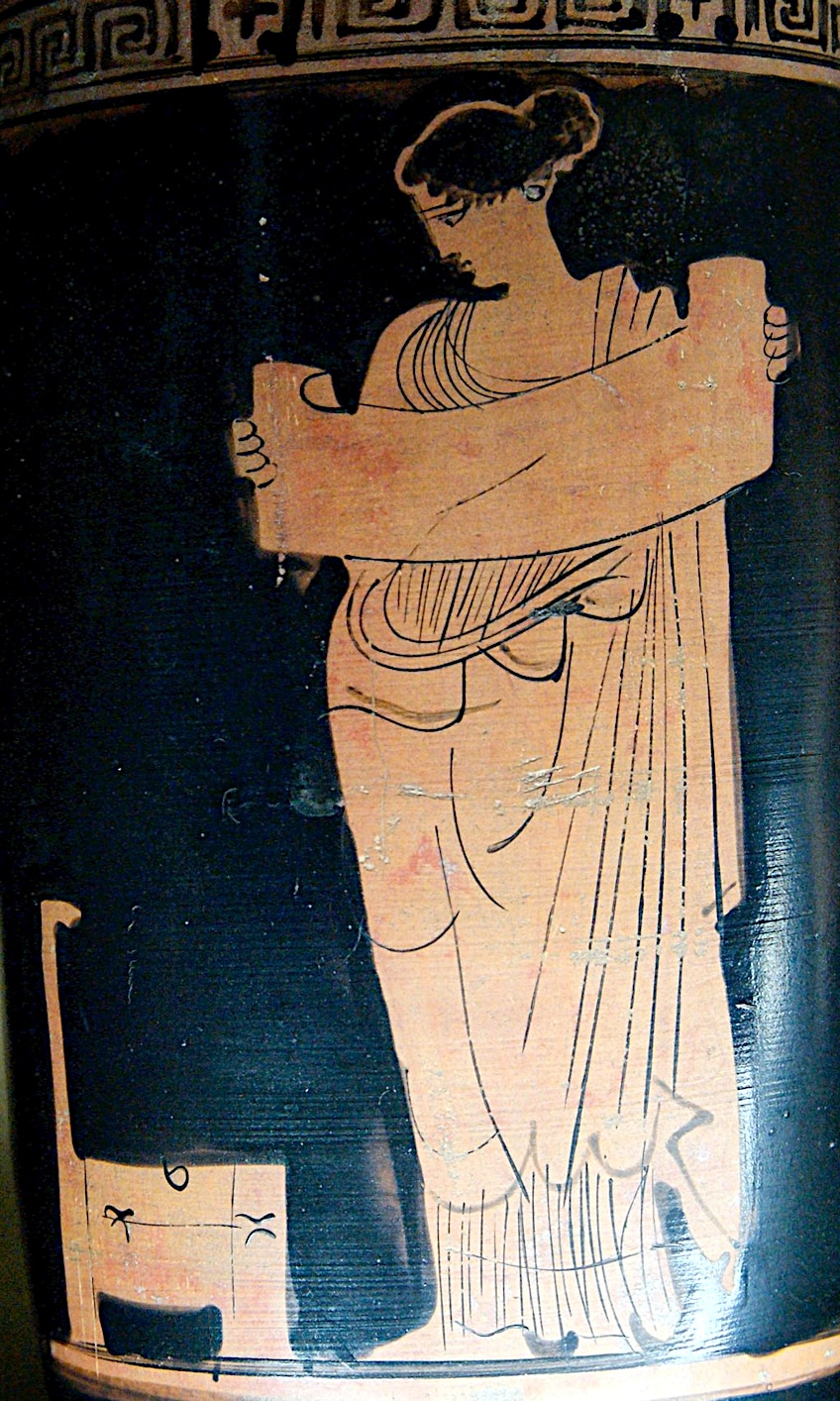 Attic red-figure lekythos showing a Muse, perhaps Clio, reading a scroll (c. 430 BCE); Louvre Museum, Public domain, via Wikimedia Commons
Attic red-figure lekythos showing a Muse, perhaps Clio, reading a scroll (c. 430 BCE); Louvre Museum, Public domain, via Wikimedia Commons
Erato
| Parents | Mnemosyne and Zeus |
| Known For | Love/erotic poetry and mimicry |
| Portrayed With | Lyre and flowers |
| Etymology | erastos (lovely/loved/charming) and/or eran (to love/to desire) |
Erato serves as the Muse of romantic and erotic poetry, and was also associated with the mimetic arts. Erato was traditionally pictured wearing a laurel wreath in ancient Greece, but since the time of the Renaissance, she has been portrayed wearing a crown covered in myrtle and flowers. She is also often seen with a zither, a type of lyre designed by Hermes. At her feet are frequently two turtle doves, and this Muse is occasionally joined by the god of love, Eros.
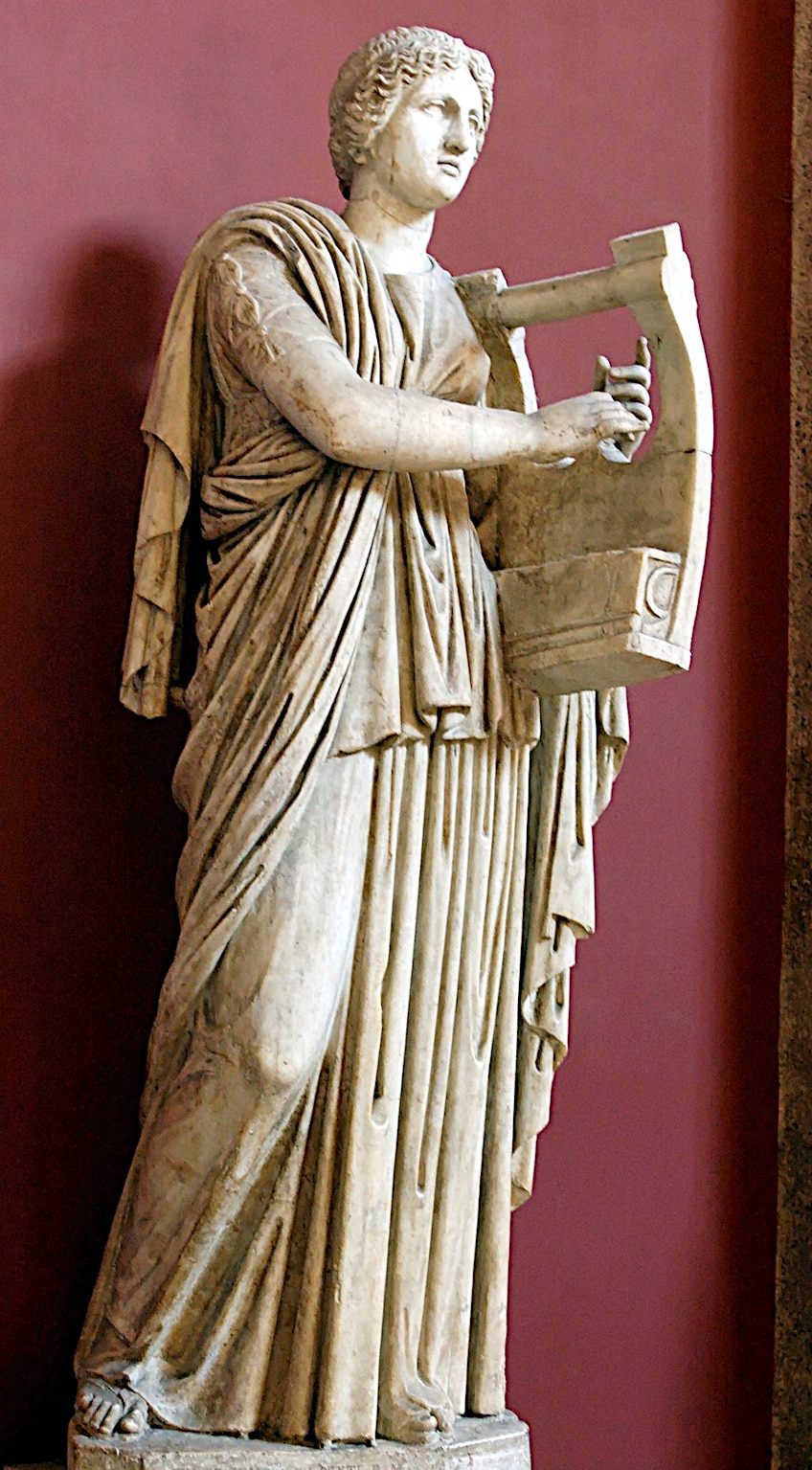 Sculpture depicting the Muse Erato (2nd Century CE) Restored in 1774 with a head from a statue of Artemis; Vatican Museums, Public domain, via Wikimedia Commons
Sculpture depicting the Muse Erato (2nd Century CE) Restored in 1774 with a head from a statue of Artemis; Vatican Museums, Public domain, via Wikimedia Commons
Euterpe
| Parents | Mnemosyne and Zeus |
| Known For | Lyrical poetry and music |
| Portrayed With | Double flute (piccolo) and crown of flowers |
| Etymology | eu (well) + terpein (to please or delight) |
Euterpe is the Muse of Lyric Poetry and music, as well as ‘the one with a pleasant genius’. While Euterpe is the Muse of all music, the double flute is her most closely connected instrument. Euterpe is credited with inventing this and other wind instruments. She is generally shown with a flower crown in her hair and a double piccolo in her hands. She is also occasionally depicted holding additional instruments such as a kithara or drums.
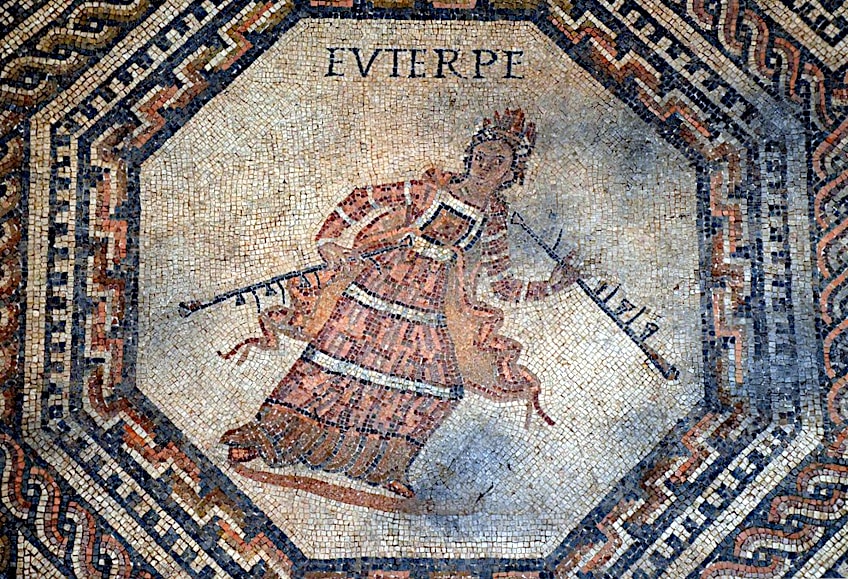 Detail of the Vichten Mosaic showing the Muse Euterpe (c. 240 CE); Following Hadrian, CC BY-SA 2.0, via Wikimedia Commons
Detail of the Vichten Mosaic showing the Muse Euterpe (c. 240 CE); Following Hadrian, CC BY-SA 2.0, via Wikimedia Commons
Euterpe had a son named Rhesus, whose fate as the warrior who perished at the hands of Diomedes at Troy was immortalized in ancient a series of ancient tragic plays controversially attributed to Euripides.
Melpomene
| Parents | Mnemosyne and Zeus |
| Known For | Theater |
| Portrayed With | Theater Mask and the club of Herakles |
| Etymology | melpomai (to celebrate with dance and song) |
Melpomene, meaning “the melodious one”, represents the theatrical part of the great festival of Dionysus where actors and choruses would reenact events from mythology. Melpomene was originally regarded as the Muse of Musical Harmony and Singing, but she later came to be known as the Muse of Tragedy. Melpomene is often seen with a diadem and opulent gowns. The major component of the image, though, is the tragic mask she holds in her hand and the club of Herakles by her side.
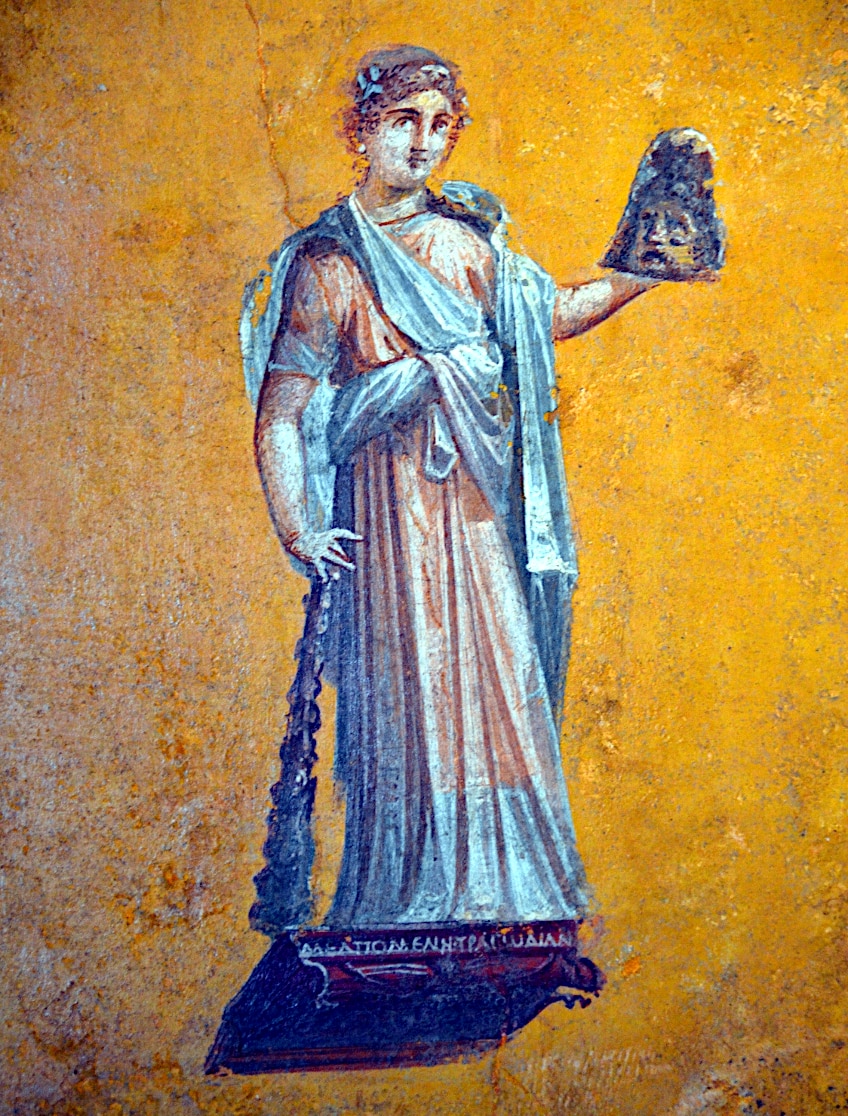 Fresco fragment depicting Muse Melpomene from Pompeii (62-79 CE); anonymous Carole Raddato from FRANKFURT, Germany, Public domain, via Wikimedia Commons
Fresco fragment depicting Muse Melpomene from Pompeii (62-79 CE); anonymous Carole Raddato from FRANKFURT, Germany, Public domain, via Wikimedia Commons
According to some accounts, Melpomene was the mother of the Sirens, the monsters whose exquisite singing lured sailors closer until they wrecked their ships on the rocks surrounding their island.
Polyhymnia
| Parents | Mnemosyne and Zeus |
| Known For | Sacred song; Dancing; Geometry; Mathematics; Lyric Poetry |
| Portrayed With | Cloak, chain or holding her finger to her mouth |
| Etymology | poly (many) + hymnos (praises/hymns) |
Various areas of expertise were attributed to Polyhymnia, ranging from sacred songs, to dancing, lyric poetry, geometry, and even mathematics. She is closely associated with scientific knowledge and is credited with inventing harmony, the lyre, and agriculture. She is often portrayed in white attire, resting on a pedestal, and staring off into the distance with a thoughtful expression. She is also occasionally pictured with a chain in her hands, symbolizing her power over being eloquent.
The depiction of her holding her finger to her mouth has been interpreted as the silence of the initiate who has been taught secret knowledge. Those who sought to make persuasive political statements would pray to Polyhymnia and seek her advice.
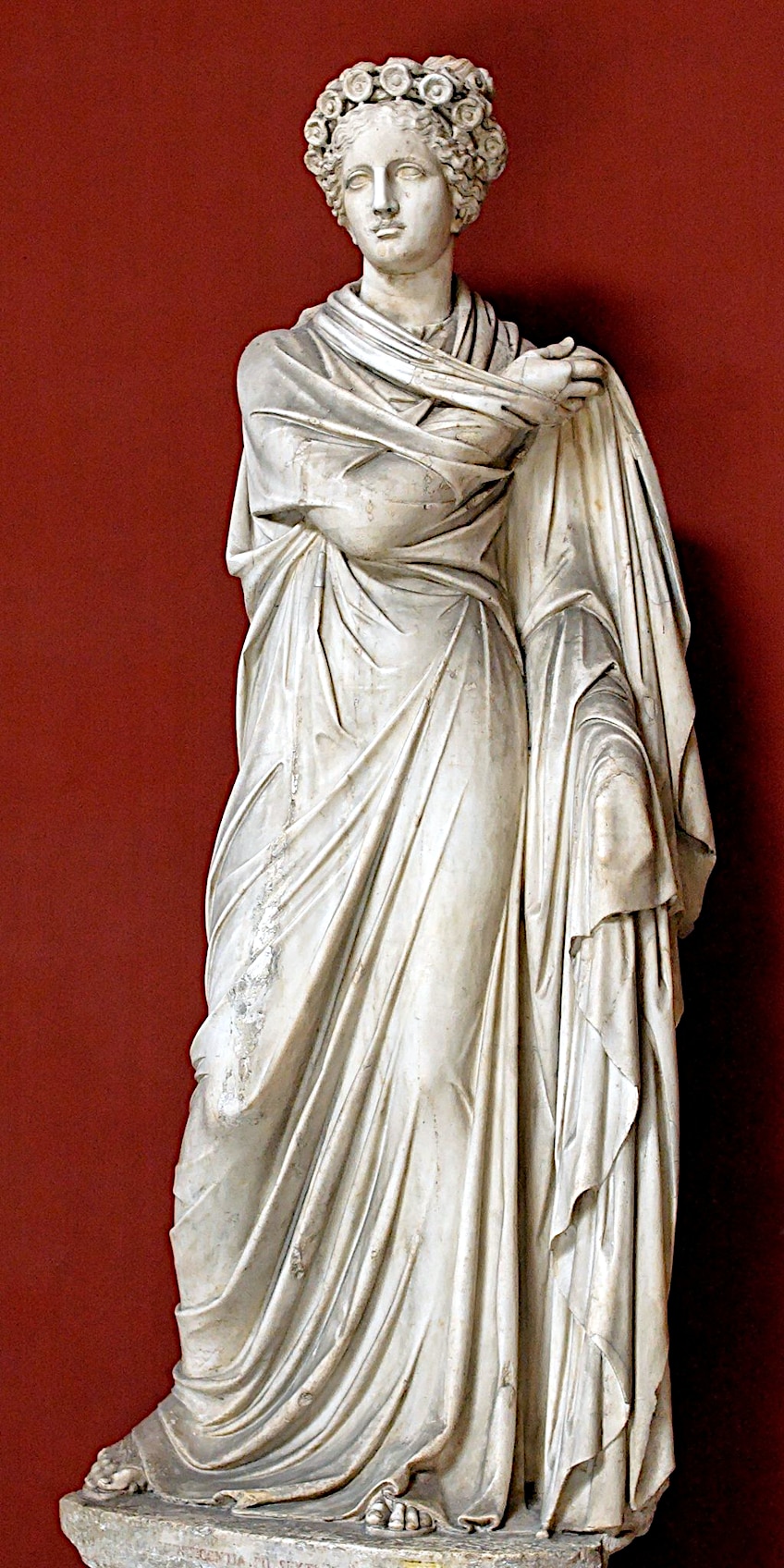 Roman statue depicting Muse Polyhymnia (2nd Century CE); Vatican Museums, Public domain, via Wikimedia Commons
Roman statue depicting Muse Polyhymnia (2nd Century CE); Vatican Museums, Public domain, via Wikimedia Commons
Thalia
| Parents | Mnemosyne and Zeus |
| Known For | Theater |
| Portrayed With | Trumpet and ivy wreath |
| Etymology | thallos (green shoot/young branch) or thallein (to blossom or bloom) |
We already stated earlier that Melpomene is one of two Greek Muses of theater, the other being Thalia. While Melpomene is connected with tragedy, Thalia is associated with festivals, humor, and nature-inspired poetry.
Tragedy was largely concerned with characters and stories from myth, while comedies regularly satirized contemporary people and events (albeit through metaphorical means).
As a result, Thalia is represented as a cheerful young female, often laughing. She is also represented with a mocking grin and a theater mask used in comedy. Many of her representations in art depict her also carrying a trumpet or a bugle, as well as a shepherd’s staff or an ivy wreath.
 Mosaic fragment depicting Muse Thalia (2nd Century CE); National Archaeological Museum of Tarragona, Public domain, via Wikimedia Commons
Mosaic fragment depicting Muse Thalia (2nd Century CE); National Archaeological Museum of Tarragona, Public domain, via Wikimedia Commons
Terpsichore
| Parents | Mnemosyne and Zeus |
| Known For | Singing and dancing |
| Portrayed With | Lyre |
| Etymology | terpsis (enjoyment/delight) + khoros (chorus) |
Terpsichore is particularly associated with choral dancing and singing. Terpsichore is sometimes represented as an elegant and attractive muse, dressed in a flowing robe and clutching a lyre. Choral dancing and singing played a very important social role in ancient Greece. Wealthy citizens would sponsor choruses ranging in size from 12 to 50 comprised of anything from boys, to girls, men and women to perform at sacred festivals. In theatrical performances, a chorus of professional actors would comment on and amplify the events in the play.
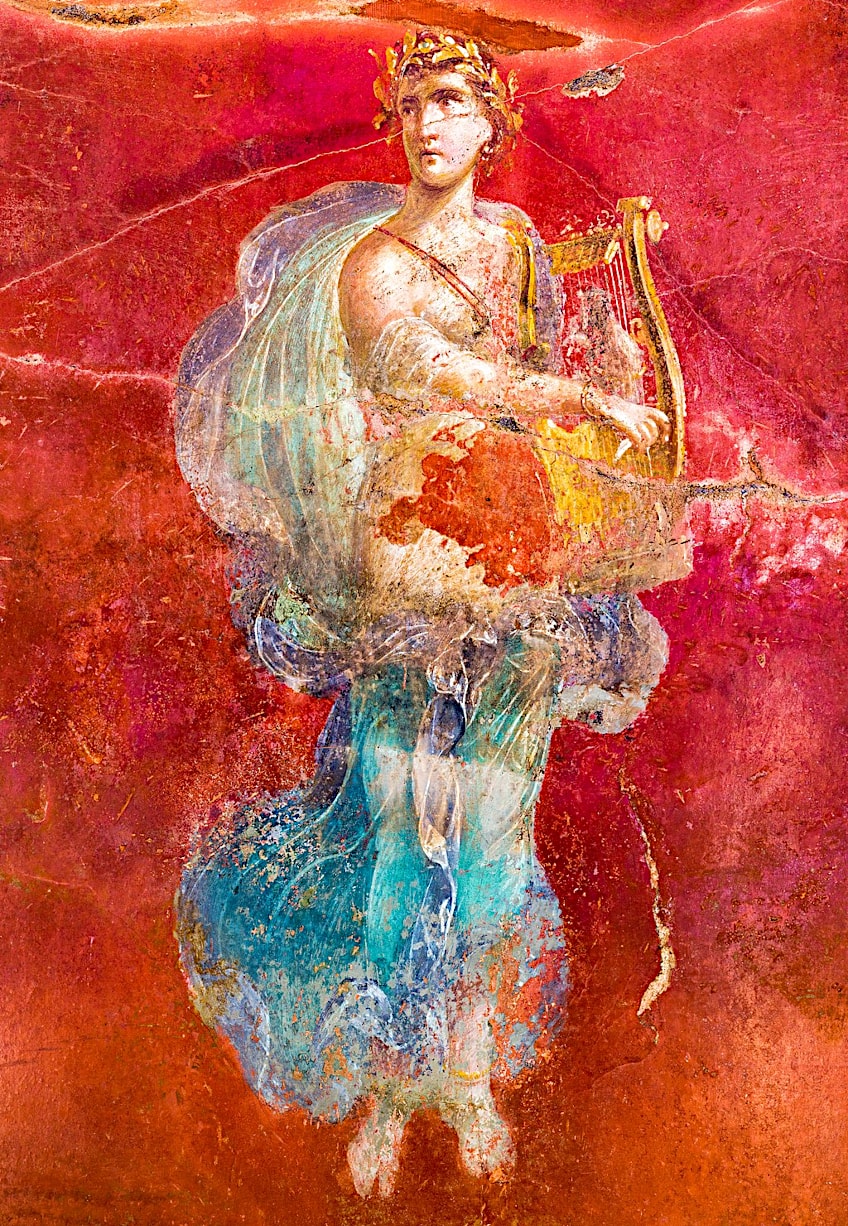 Fresco from Pompeii depicting Muse Terpsichore (c. 64 CE); ArchaiOptix, CC BY-SA 4.0, via Wikimedia Commons
Fresco from Pompeii depicting Muse Terpsichore (c. 64 CE); ArchaiOptix, CC BY-SA 4.0, via Wikimedia Commons
Dance was an integral aspect of how ancient Greek civilization perceived concepts like harmony and the soul. Dance and music were regarded as important components of schooling as these were closely associated with notions of harmony, order, and social cohesion.
The customary education of the Agoge in ancient Sparta required parents to train their children to dance at the age of five. Dancing was also used to praise the gods and celebrate festivals. Unchoreographed orgiastic dance was especially important in the ecstatic cult of Dionysus. He had a unique set of female followers known as the Maenads, whose rituals involved drinking wine and dancing wildly.
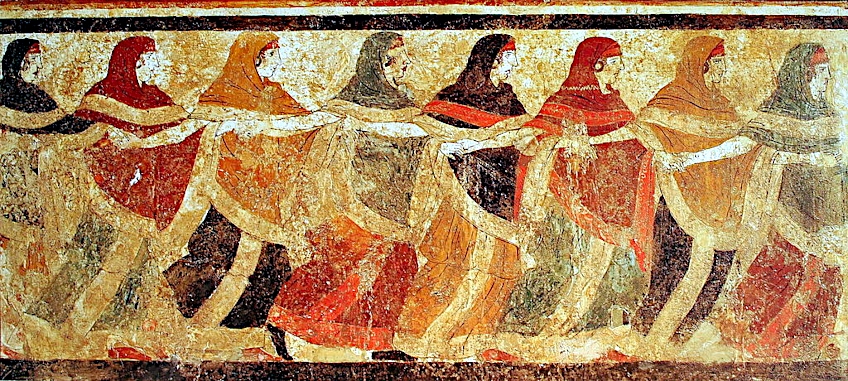 Fresco of dancing Peucetian women from the Tomb of the Dancers in the Corso Cotugno necropolis of Ruvo di Puglia (end of the 5th or mid-4th Century BCE); Naples National Archaeological Museum, Public domain, via Wikimedia Commons
Fresco of dancing Peucetian women from the Tomb of the Dancers in the Corso Cotugno necropolis of Ruvo di Puglia (end of the 5th or mid-4th Century BCE); Naples National Archaeological Museum, Public domain, via Wikimedia Commons
Urania
| Parents | Mnemosyne and Zeus |
| Known For | Astronomy |
| Portrayed With | Crown of stars; celestial globe and compasses |
| Etymology | ouranios (heavenly) |
Urania, the Muse of Astronomy, is the youngest of the nine goddesses of the arts. Urania’s name is thought to have inspired numerous observatories and astronomical societies. Urania is frequently depicted wearing a blue dress and holding celestial globe and compasses. She is portrayed with a crown of stars on her head and a variety of mathematical tools at her feet. As a result, Urania is also known as the Greek Muse of Mathematics. Urania could use her knowledge of the movement of the stars to predict future events.
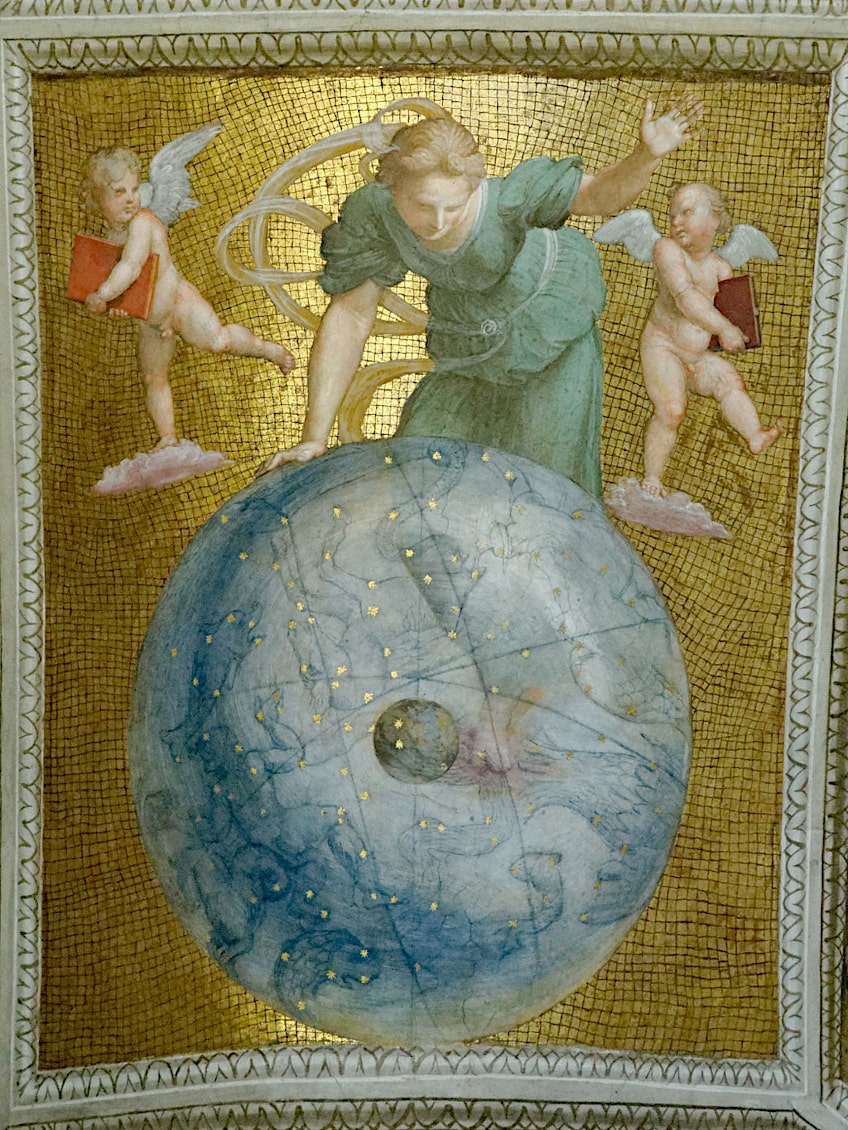 Muse Urania with a celestial sphere by Raphael (between 1508 and 1511); Raphael, Public domain, via Wikimedia Commons
Muse Urania with a celestial sphere by Raphael (between 1508 and 1511); Raphael, Public domain, via Wikimedia Commons
Most ancient Greek rituals had to be performed on specific dates to coincide with the appearance of particular stars or constellations in the sky, meaning that a comprehensive knowledge of astronomy was required to plan and properly execute important rituals and festivals.
The Greek Muses’ Role in Inspiring Creativity
The idea of the Muse has evolved considerably since antiquity. While originally regarded as the primary source of tradition and reliable information, the Muse gradually changed to become a figure associated with idiosyncratic genius and innovation. In popular culture, a muse is seen as the purest form of artistic inspiration, a metaphor for the conditions required to attain brilliance in any creative endeavor.
The idea of the Greek Muses and their role in encouraging creativity has left an indelible mark on Western society. Even today, the term “muse” is used to describe someone who inspires or acts as a source of inspiration for artists, designers, musicians, and other creatives.
The Greek Muses in Cults and Modern Museums
When Pythagoras visited Croton, his first piece of advice to the Crotoniates was to construct a shrine to the Muses in the city center to encourage civic peace and study. Local Muse cults were frequently connected with fountains or springs. Because of their link with the Aganippe fountain, the Greek Muses were often referred to as Aganippids. Pirene and Hippocrene fountains were additional major locales linked with the Muses. They were often described as “Corycides”, named after a cave on Mount Parnassos known as the Corycian Cave.
The Greek Muses were particularly revered at Boeotia, Delphi, and Parnassus, where Apollo became known as Mousēgetēs (leader of the chorus of Muses).
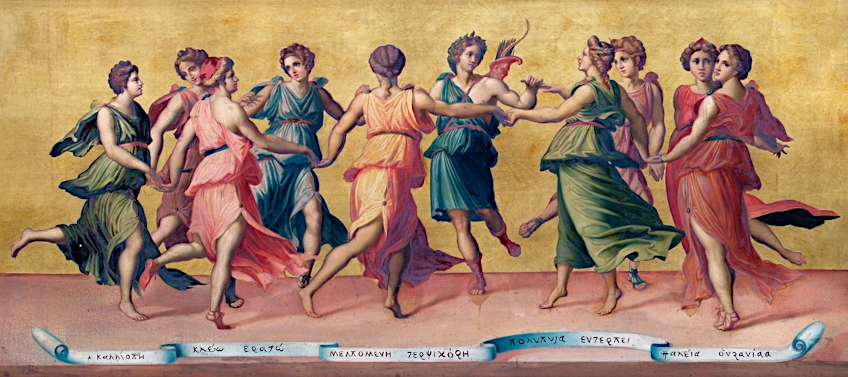 Apollo and the Nine Muses by Baldassare Peruzzi (c. late 15th or early 16th Century); Baldassare Peruzzi, Public domain, via Wikimedia Commons
Apollo and the Nine Muses by Baldassare Peruzzi (c. late 15th or early 16th Century); Baldassare Peruzzi, Public domain, via Wikimedia Commons
Muse-worship was often connected with poet hero-cults: the graves of Archilochus on Thasos, as well as Thamyris and Hesiod in Boeotia, all hosted festivals in which lyrical recitations accompanied tributes to the Muses. The Library of Alexandria and its scholars built a Muse shrine near Alexander the Great’s tomb. In the 18th century, many figures of the Enlightenment attempted to reestablish a “Cult of the Muses”. As a result of this effort, the term “museum” evolved to refer to a public exhibition of knowledge.
Famous People Inspired by the Greek Muses
Numerous notable artists, authors, and musicians have evoked or were influenced by the notion of the Muses in their endeavors of creativity throughout history. The great English playwright and poet Shakespeare regularly evoked the Muses of Comedy and Tragedy. The renowned German musician and composer, Johann Sebastian Bach, widely regarded as one of the finest creators of Western classical music, drew inspiration from Euterpe, the Greek Muse of music.
The Italian poet who wrote The Divine Comedy, Dante Alighieri, took inspiration for his epic masterwork from the Muses, notably Calliope.
In his cosmic and celestial themes, English poet John Milton used the Muses for inspiration, notably Urania, the Muse of Astronomy. Ludwig van Beethoven, the prominent composer from Germany, is believed to have drawn inspiration for his musical works from the Muses. William Wordsworth was regarded as one of the most important English Romantic writers, Wordsworth was influenced by the Muses in his poetry, especially on topics related to the environment and the human soul.
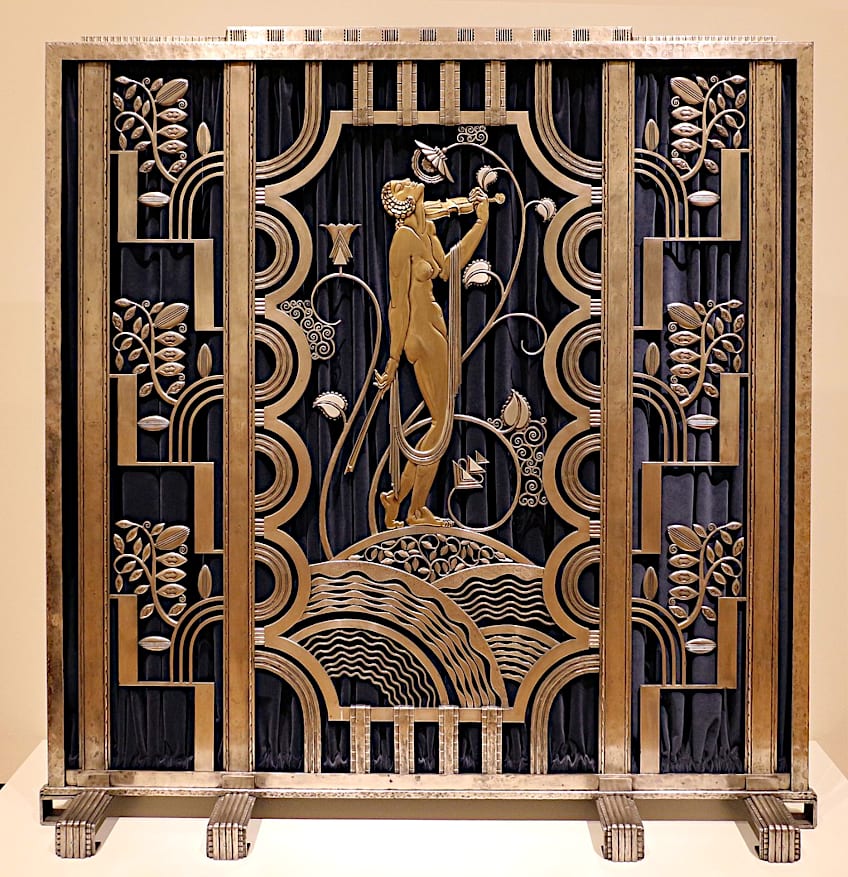 Muse with Violin by Paul Fehér (1929); Sailko, CC BY 3.0, via Wikimedia Commons
Muse with Violin by Paul Fehér (1929); Sailko, CC BY 3.0, via Wikimedia Commons
During the period known as Art Nouveau, Gustav Klimt, the Austrian symbolist painter took inspiration from the Muses to produce gorgeous and opulent works of art.
In several of his works and poetry, Jim Morrison, the lead vocalist, and songwriter of the rock band The Doors, referenced the Muses, embracing the notion of creative inspiration. The American poet Maya Angelou, often referred to the Muses in her writings, recognizing the importance of creative inspiration in her powerful compositions, while the Muse Urania is frequently addressed in the poetry of Joseph Brodsky.
Novelist John Fowles has an arrogant writer named Miles Green engage in a series of contests with the Muse Erato in his 1982 book Mantissa. As a Modernist, Miles Green refuses to acknowledge his creative debt to literary tradition, represented in the novel by his adversary the Muse, whom he treats as an erotic irrelevance. As with Thamyris, every time the errant writer loses to the Muse, she punishes him by taking away his memory.
This completes our look at the nine goddesses of the arts. The Greek Muses were the goddesses of the sciences and the arts in Greek mythology. They were the daughters of Zeus and Mnemosyne, as well as the companions of Apollo. The Greek Muses were an ongoing source of inspiration for all artists and had a significant part in the creative development of the Ancient Greeks. The Greek Muses were extensively adored until Christianity became Europe’s main religion. The Muses are appear more often as the source than the content of the narrative in Greek mythology.
Frequently Asked Questions
Who Are the Muses in Greek Mythology?
The muses were the source of knowledge in Greek mythology. They ruled over the sciences and arts, often assisting and directing individuals to brilliant ideas and discoveries. The Muses dwelt on mountains such as Helicon, Parnassus, and Piera and were regularly accompanied by the deity Apollo, whose territory overlapped with the Muses. He was in charge of concepts like light, music, poetry, eloquence, and the sun. Ancient bards would ask the muses to assist them in singing or remembering the epic stories of heroines and heroes.
Who Are the Nine Goddesses of the Arts?
Hesiod informs us that there were nine goddesses of the arts, and most subsequent authors, particularly since Roman times, agree with him. In Greek mythology, Thalia was regarded as the Muse of Comedy, and she was often portrayed with a shepherd’s crook and comedy mask. Urania was regarded as the Muse of Astronomy, and she was often seen carrying a celestial globe. Melpomene is regarded as the Muse of Tragedy, and she is usually portrayed with the mask of tragedy. Polyhymnia was regarded as the Muse of Sacred Poetry and Hymns, and she often appeared with a sad expression buried beneath a veil. Erato was the Muse of Lyric Poetry, and she is often shown holding a lyre. Calliope was the Epic Poetry Muse. Hesiod believes she was the first of the nine because she attends to kings and rulers. Calliope regularly appears clutching a writing pad. The rest of the Muses are Clio (history), Terpischore (choral dancing), and Euterpe (music and poetry).

I am deeply passionate about history and am constantly fascinated by the rich and complex stories of the past. As the editor-in-chief of learning-history.com, I have the opportunity to share this passion with a wide audience through the creation and distribution of engaging and informative content about historical events, persons, and cultures. Whether it’s through writing articles and blog posts or creating videos or podcasts, I strive to bring the past to life in a way that is both accurate and enjoyable. My expertise in history, combined with my strong writing and communication skills, allows me to effectively communicate complex historical concepts and make them accessible and interesting to a wide range of readers. I am truly grateful for the opportunity to share my love of history with others through my work on learning-history.com.

